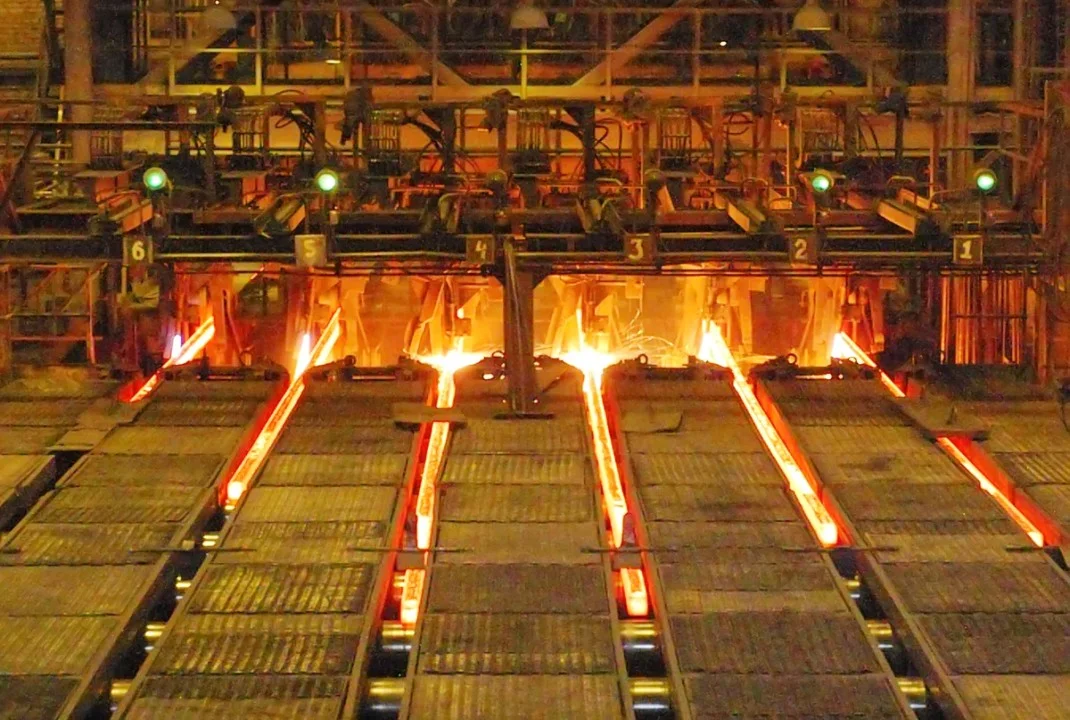Continuous casting is a modern manufacturing process used in the metallurgy industry to produce metal shapes with a constant cross-section, such as billets, slabs, and rods. The process involves continuously pouring molten metal into a water-cooled mold, which solidifies and forms the desired shape as it passes through a series of rollers or cooling zones. Continuous casting is employed primarily in the production of steel, aluminum, and other metals and alloys. It offers several advantages over traditional ingot casting methods, making it a preferred choice for many industries.
One of the primary reasons for using continuous casting is efficiency. This process enables a continuous and uninterrupted production of metal shapes, eliminating the need for repeated stopping and starting associated with ingot casting. This results in higher production rates and reduced energy consumption per unit of metal produced. Additionally, continuous casting produces a more homogeneous and refined microstructure in the metal, leading to improved mechanical properties and product quality. The consistent cross-sectional dimensions of the cast product also make it easier to process and further reduce material waste in subsequent manufacturing steps. Overall, continuous casting helps streamline production, improve product quality, and enhance the cost-effectiveness of metal manufacturing processes.
Continuous casting is particularly advantageous in the production of heat-treatable steel, where maintaining precise metallurgical properties is essential. This process ensures consistent quality and uniformity, making it an ideal choice for industries that require heat-treatable steel for applications demanding specific mechanical properties and performance standards. By continuously producing heat-treatable steel with controlled cooling rates, continuous casting contributes to the enhanced durability and reliability of the final products in various industries.
The Basics of Continuous Casting Technology

The Basics of Continuous Casting Technology
Continuous casting is a sophisticated industrial process used to produce semi-finished or finished metal products with a consistent cross-sectional shape, such as slabs, billets, and rods. The basic principles of continuous casting involve the following steps:
- Melting: The process begins with the melting of metal in a furnace. Depending on the type of metal or alloy being cast, this can be done in electric arc furnaces, induction furnaces, or other specialized melting equipment. The molten metal is heated to the appropriate temperature for casting.
- Tundish: The molten metal is then transferred to a tundish, which acts as a reservoir that ensures a steady and controlled flow of metal into the casting mold. The tundish also helps remove impurities and gases from the molten metal.
- Mold: The heart of the continuous casting process is the casting mold. It is typically made of copper or other highly conductive materials and is water-cooled to rapidly solidify the molten metal. As the metal flows into the mold, it takes on the shape and dimensions of the desired product.
- Withdrawal: As the metal begins to solidify in the mold, it is continuously withdrawn from the bottom at a controlled rate. This pulling force is applied by a set of rollers or withdrawal equipment. The solidifying metal passes through a series of cooling zones, which further refine the microstructure and mechanical properties of the product.
- Cutting and Coiling: Once the metal has solidified to the desired length, it is cut into manageable pieces using cutting devices. These pieces can be coiled or transferred for further processing, depending on the specific application.
Continuous casting offers several advantages, including improved product quality, reduced energy consumption, and increased production efficiency. It is widely used in the manufacturing of steel, aluminum, and other metals due to its ability to produce high-quality, uniform products with minimal waste and downtime.
How Continuous Casting Works: Step by Step
Continuous casting is a complex industrial process used for efficiently producing metal shapes with consistent cross-sections. Here’s a step-by-step overview of how continuous casting works:
- Melting: The process starts with the melting of raw materials, such as scrap metal or primary metal sources, in a furnace. The furnace can be an electric arc furnace (EAF), an induction furnace, or other types, depending on the specific metal being processed. The goal is to melt the metal to a precise temperature suitable for casting.
- Transfer to the Tundish: Once the metal is molten and at the right temperature, it is transferred into a tundish, which serves as an intermediate reservoir. The tundish ensures a constant and controlled flow of molten metal into the casting mold. It also helps in removing impurities and gases from the metal.
- Casting Mold: The molten metal flows from the tundish into the casting mold, which is typically made of copper or other highly conductive materials. The mold has the shape and dimensions of the desired product. As the metal enters the mold, it rapidly cools and solidifies against the inner surface, taking on the shape of the mold.
- Continuous Withdrawal: The solidified metal is continuously withdrawn from the bottom of the mold at a controlled rate. This is achieved through the use of rollers or withdrawal equipment that exert a constant pulling force. As the metal is pulled out of the mold, it passes through a series of cooling zones, where water or other cooling mediums are used to further solidify and cool the metal.
- Cutting and Final Products: When the metal has reached the desired length, it is cut into individual pieces using cutting devices. These pieces, now in the form of slabs, billets, or rods, can be coiled or transferred for additional processing or used as semi-finished or finished products, depending on the industry’s requirements.
Continuous casting offers several advantages, including improved product quality, reduced energy consumption, and increased production efficiency. It is a crucial technology in the metal industry, enabling the production of high-quality, uniform products with minimal material waste and downtime.
Advantages of Continuous Casting Over Traditional Methods
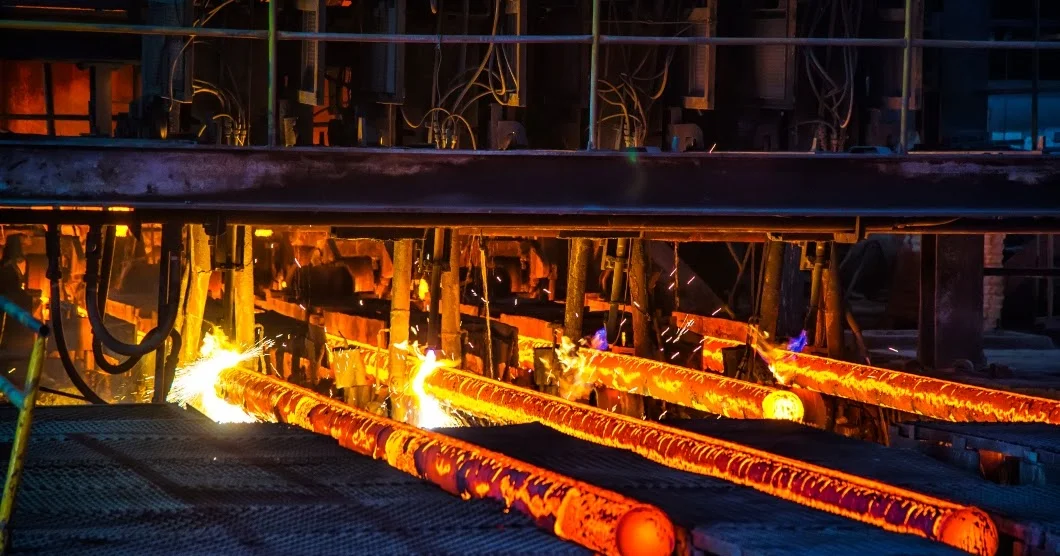
Advantages of Continuous Casting Over Traditional Methods
Continuous casting offers several significant advantages over traditional casting methods, such as ingot casting. Here are some key advantages:
Higher Efficiency: Continuous casting is a highly efficient process that allows for the continuous production of metal shapes without the need for frequent stops and starts. In contrast, traditional ingot casting involves pouring molten metal into individual molds, allowing them to solidify, and then removing and reusing the molds. This stop-and-start nature results in lower production rates and higher energy consumption. Continuous casting eliminates these interruptions, leading to higher productivity and reduced energy usage per unit of metal produced.
Improved Product Quality: Continuous casting leads to superior product quality compared to traditional casting methods. The continuous, controlled cooling in the casting mold results in a more uniform microstructure within the metal, reducing the presence of defects such as porosity and segregation. This leads to higher mechanical properties and better overall product consistency. Additionally, the consistent cross-sectional dimensions of continuous-cast products make them easier to process in subsequent manufacturing steps, reducing the need for extensive machining and material waste.
Reduced Material Waste: Continuous casting generates minimal material waste compared to ingot casting, where the molds are often discarded or recycled after each use. In continuous casting, the molds are reusable, and the process generates very little scrap. This reduction in material waste is not only environmentally beneficial but also cost-effective, as it leads to significant savings in raw material costs.
Enhanced Process Control: Continuous casting provides greater control over the casting process, allowing for adjustments in real-time to meet specific product requirements. Operators can monitor and adjust parameters such as casting speed, cooling rates, and alloy composition, ensuring that the final product meets the desired specifications consistently.
Versatility: Continuous casting is versatile and can be used to produce a wide range of metal shapes and sizes, from small rods to large slabs. This versatility makes it suitable for various industries, including steel, aluminum, copper, and more.
Overall, continuous casting is a preferred method in the metallurgy industry due to its efficiency, product quality improvements, waste reduction, and process control advantages over traditional casting methods.
Quality Control in Continuous Casting
Quality control is a critical aspect of continuous casting to ensure that the produced metal products meet the required specifications and standards. Here are some key aspects of quality control in continuous casting:
Process Monitoring: Continuous casting involves several parameters that need to be closely monitored. This includes monitoring the temperature of the molten metal, the casting speed, the water cooling rates in the mold and secondary cooling zones, and the position and alignment of the casting equipment. Advanced sensors and monitoring systems are used to collect data in real-time. Any deviations from the desired values can trigger alarms and prompt corrective actions.
Mold Design and Maintenance: The mold is a crucial component in continuous casting as it shapes the final product. Proper mold design and maintenance are essential to ensure a consistent and defect-free product. Quality control involves regular inspections of the mold for wear, cracks, and other issues that could affect the surface finish and dimensions of the cast product. Mold lubrication and coating processes are also monitored to ensure optimal release properties and minimize surface defects.
Metal Analysis: Continuous casting requires precise control over the composition of the molten metal. Quality control includes regular sampling and analysis of the metal to confirm that it meets the specified chemical composition. Any variations in alloy composition can lead to product defects or inconsistencies in mechanical properties.
Inspection and Testing: After the continuous casting process, the resulting products undergo various inspection and testing procedures. This includes visual inspection for surface defects, dimensional measurements to ensure the correct cross-sectional dimensions, and non-destructive testing methods like ultrasonic or magnetic particle testing to check for internal defects. Tensile and other mechanical tests are performed to verify the product’s mechanical properties.
Documentation and Traceability: Quality control in continuous casting also involves rigorous documentation and traceability. Each batch of metal produced is documented, including information on the casting parameters, alloy composition, and test results. This documentation helps track the quality of products and allows for the identification and resolution of any quality issues that may arise.
Continuous casting quality control is essential not only for meeting customer specifications but also for ensuring the safety and reliability of the final products, especially in critical applications like aerospace and automotive industries. By maintaining strict quality control measures throughout the continuous casting process, manufacturers can produce high-quality, consistent, and defect-free metal products.
Continuous Casting in the Steel Industry
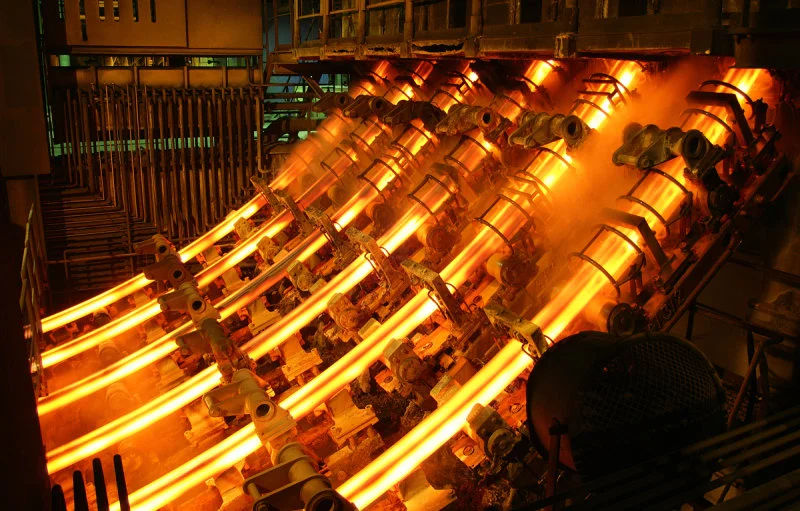
Continuous Casting in the Steel Industry
Continuous casting is a fundamental process in the steel industry, offering numerous advantages. It revolutionizes steel production by allowing for continuous, uninterrupted manufacturing of steel shapes like slabs, billets, and blooms. This results in higher efficiency and productivity compared to traditional batch methods. Continuous casting also enhances product quality through controlled cooling, leading to a more homogeneous microstructure and fewer defects. It significantly reduces material waste by reusing molds and offers flexibility in producing various steel products, making it a cornerstone of the steel industry’s efficiency, quality, and sustainability efforts.
The Role of Continuous Casting in Non-Ferrous Metals
Continuous casting is not limited to the steel industry and plays a crucial role in the production of non-ferrous metals as well. Non-ferrous metals, such as aluminum, copper, and brass, benefit from continuous casting for several reasons.
Continuous casting in non-ferrous metals offers similar advantages as in the steel industry. It enhances production efficiency by allowing for a continuous and uninterrupted process, reducing the need for frequent stops and starts associated with traditional casting methods. This results in higher productivity and cost savings. Additionally, the controlled cooling and solidification in the continuous casting mold lead to improved product quality with a more uniform microstructure, reduced defects, and enhanced mechanical properties.
In the non-ferrous metals industry, continuous casting is commonly used to produce a variety of shapes, including billets, bars, rods, and strips. This versatility makes it suitable for a wide range of applications, from the automotive and aerospace industries to electrical and construction sectors. Whether it’s aluminum for lightweight vehicle components or copper for electrical wiring, continuous casting is a vital technology that ensures the efficient and high-quality production of non-ferrous metal products.
Continuous Casting Applications in Automotive Manufacturing
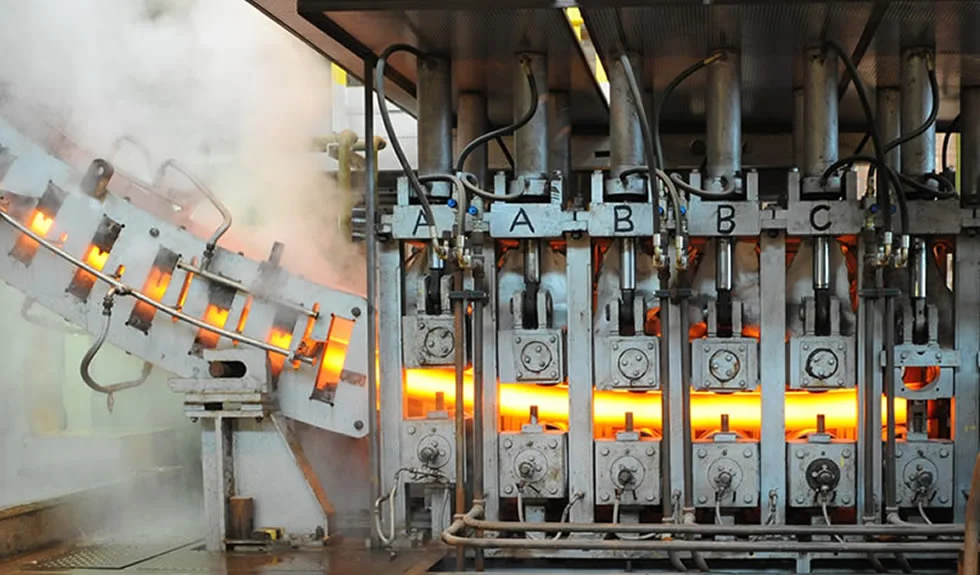
Continuous Casting Applications in Automotive Manufacturing
Continuous casting plays a significant role in the automotive manufacturing industry by supplying high-quality, uniform metal products that are essential for producing various vehicle components. Here are some key applications of continuous casting in automotive manufacturing:
Engine Components: Continuous casting is widely used to produce the metal alloys required for engine components such as cylinder heads, engine blocks, and crankshafts. These components demand materials with precise metallurgical properties and high structural integrity. Continuous casting ensures that the metal used in these critical parts is free from defects, uniform in composition, and possesses the necessary strength and durability.
Suspension and Chassis Parts: The suspension and chassis of a vehicle require sturdy and reliable materials to ensure safety and stability. Continuous casting provides the automotive industry with high-quality steel and non-ferrous metal products used for suspension components like control arms, shock absorber housings, and chassis parts like frame rails. The consistent cross-sectional dimensions and superior mechanical properties of continuous-cast materials are essential for these applications.
Transmission and Drivetrain: Continuous casting also plays a role in the production of transmission and drivetrain components, such as gear blanks, clutch housings, and differential cases. These parts require materials that can withstand high loads and provide reliable performance. Continuous casting ensures that the metal used in these components has the required mechanical properties and dimensional accuracy.
Wheels and Brakes: The automotive industry relies on continuous casting to produce aluminum and alloy materials for wheels and brake components. Continuous-cast aluminum alloys offer lightweight solutions without compromising strength, making them ideal for wheels, brake calipers, and brake rotors. These components benefit from the consistent quality and precision achieved through continuous casting.
Overall, continuous casting in the automotive manufacturing sector is essential for ensuring the production of high-performance, reliable, and safe vehicles. It contributes to the efficiency and cost-effectiveness of automotive manufacturing processes while meeting stringent quality and performance standards.
Continuous Casting’s Impact on Aerospace Engineering
Continuous casting plays a significant role in aerospace engineering by providing the aerospace industry with high-quality metal materials that are critical for manufacturing components used in aircraft and spacecraft. Here are some ways continuous casting impacts aerospace engineering:
High-Strength and Lightweight Materials: Aerospace applications demand materials that are both strong and lightweight to ensure the structural integrity and fuel efficiency of aircraft and spacecraft. Continuous casting enables the production of advanced alloys with precisely controlled metallurgical properties. These materials, such as aluminum, titanium, and nickel-based alloys, are used in the construction of critical components like airframes, engine parts, and structural components. Continuous casting ensures that these materials are free from defects, possess consistent mechanical properties, and meet the stringent requirements of the aerospace industry.
Precision Components: Aerospace engineering often involves the manufacturing of precision components, where dimensional accuracy and material consistency are paramount. Continuous casting provides materials with uniform cross-sectional dimensions, making them well-suited for components like turbine blades, landing gear components, and structural elements. The ability to produce these components from continuous-cast materials helps maintain the high safety and reliability standards required in aerospace engineering.
Efficiency and Cost Reduction: Continuous casting contributes to the efficiency and cost-effectiveness of aerospace manufacturing processes. It minimizes material waste by providing materials with consistent properties, reducing the need for extensive machining or additional processing to correct defects. This not only saves valuable resources but also helps aerospace manufacturers meet production schedules and cost targets.
Continuous casting has a profound impact on aerospace engineering by supplying materials that are fundamental to the construction of aircraft and spacecraft. It ensures the production of high-performance, reliable, and lightweight components, contributing to the safety, efficiency, and innovation in the aerospace industry.
Continuous Casting in Building and Construction
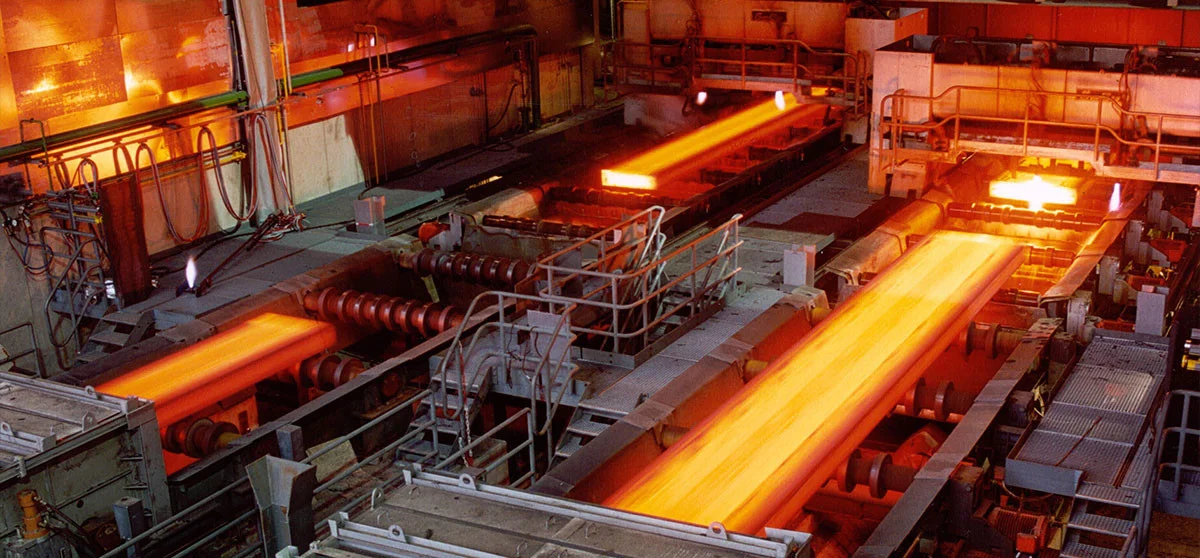
Continuous Casting in Building and Construction
Continuous casting is integral to the building and construction industry, providing a reliable source of high-quality construction materials. Steel billets produced through continuous casting are essential for reinforcing concrete structures with reinforcement bars (rebar), enhancing the safety and durability of buildings, bridges, and highways. Continuous casting also supplies non-ferrous materials like aluminum and brass, which are used in architectural elements such as window frames, door handles, and decorative facades, contributing to both aesthetics and functionality in construction projects.
Additionally, continuous casting plays a role in producing metal pipes, tubing, and structural components, ensuring dimensional consistency, corrosion resistance, and the necessary mechanical strength for plumbing, HVAC systems, and larger-scale construction endeavors like bridges and high-rise buildings. Overall, continuous casting supports the construction industry in delivering reliable, durable, and visually appealing structures and building elements.
REFERENCES:
Mills, K. C., Ramirez-Lopez, P., Lee, P. D., Santillana, B., Thomas, B. G., & Morales, R. (2014). Looking into continuous casting mould. Ironmaking & Steelmaking, 41(4), 242-249.
Dauby, P. H. (2012). Continuous casting: make better steel and more of it!. Metallurgical Research & Technology, 109(2), 113-136.
Harter, I. (1951, January). The Continuous Casting of Steel. In Proceedings of the American Academy of Arts and Sciences (Vol. 79, No. 2, pp. 47-59). American Academy of Arts & Sciences.

